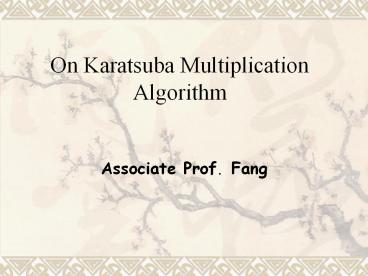On Karatsuba Multiplication Algorithm - PowerPoint PPT Presentation
1 / 18
Title:
On Karatsuba Multiplication Algorithm
Description:
(radix 232) Table 1: the computation time comparison of three algorithms. Where Digits is the length of multiplier integer in radix 232 representation. ... – PowerPoint PPT presentation
Number of Views:1186
Avg rating:3.0/5.0
Title: On Karatsuba Multiplication Algorithm
1
On Karatsuba Multiplication Algorithm
- Associate Prof. Fang
2
1. Introduction
Certain public key cryptographic algorithms such
as RSA and ECC, the large integer multiplication
is the basic operation of multiple precision
integer arithmetic
3
1. Introduction
- The literature about multiplication arithmetic
covers - Classical Knuth multiplication(O(n2))
- Karatsuba multiplication(O(nlog3))
- Fast Fourier Transform trick(O(nlogn))
- Schönhage-Strassen trick(O(nlognloglogn))
4
1. Introduction
Most of the multiplication techniques are divide
and conquer tools. But, Daniel J. Bernstein
said It is a mistake to use a single method
recursively all the way down to tiny problems.
The optimal algorithm will generally use a
different method for the next level of reduction,
and so on.
5
1. Introduction
My short paper presents a new multiplication
trick by using classical Knuth multiplication and
Karatsuba multiplication, and finds the condition
under which the efficiency of multiplication is
optimal in theory and in practice.
6
2. Classical Knuth multiplication
Let p(u1u2un)b, q(v1v2vm)b, the product
is wpq(w1w2wmn)b. Here is the classical
Knuth multiplication to compute the product
w step1. w1, w2,,wmn?0, j?m step2. if vj 0
then wj?0 goto step6 step3. i?n, k?0 step4.
t?uivjwijk, wij?t mod b, k ?
step5. i?i-1, if igt0 then goto step4 else
wj?k step6. j?j-1, if jgt0 then goto step2 else
exit It is obvious that the time complexity of
this algorithm is O (mn).
7
3. Karatsuba multiplication
Let p(u1u2un)b, q(v1v2vn)b. In 1963,
Karatsuba wrote pq as the following formula
where r0 p0q0 , r1 p1q1, r2 ( p1 p0 )(q1
q0 ) . We can obtain the product by using
divide and conquer method recursively. Let T(n)
be computation time of multiplication pq, we can
get the recursion of time complexity easily
So we get T(n)9nlog3-10nO(nlog3)
8
4. A new multiplication trick
Theorem 1. There exists n such that the
computational time of Knuth classical
multiplication is less than that of Karatsuba
multiplication.
9
4. A new multiplication trick
Proof Let T1(n) be computation time of
classical Knuth multiplication and T2(n) be
computation time of Karatsuba multiplication.
According to the previous analysis, we
have T1(n)n2, T2(n)9nlog3-10n There exists n
such that T1(n)T2(n), that is n2 9 nlog 3 -10n
lt 9 nlog 3 we can calculate Therefore, if
nlt256, then classical Knuth multiplication is
more efficient than Karatsuba multiplication.
10
4. A new multiplication trick
Theorem 2 the efficiency of Karatsuba
multiplication is optimal when ngt16(n2k),
Karatsuba multiplication algorithm is called
recursively, and if n16, then recursion call is
returned, classical Knuth multiplication is used
to compute the product of two smaller
integers. Proof Let T(n) be computation time of
Karatsuba multiplication. We assume that if ngtm
then Karatsuba algorithm is called recursively,
else classical Knuth multiplication is used.
Therefore, we have
11
4. A new multiplication trick
Let n2k, h(k)T(n)T(2k), T(n) can be written as
Let m2i, we get
Let f(i)(4i102i)/3i, the value of function
f(i) is minimum when
That is, when i4, m2i16, the value of T(n) is
minimum.
12
5. Experiment results and conclusion
Precondition some simple assembly language codes
may be called to compute the product of two
32-bit positive integers. The time complexity of
this base operation is O(1). _ _asm mov eax,
x xor edx, edx mul y Product in edxeax mov
ebx, p mov dword ptr ebx, eax mov dword ptr
ebx4, edx
13
5. Experiment results and conclusion
Test environmentAMD Athlon CPU 1.1GHz, 256M RAM,
Windows XP OS and MS Visual C 6.0 compiler.
14
5. Experiment results and conclusion
Table 1 the computation time comparison of three
algorithms
Where Digits is the length of multiplier integer
in radix 232 representation.
15
5. Experiment results and conclusion
Table 1 shows that the new multiplication trick
obviously decreases computational time than that
of the classical Knuth multiplication and
Karatsuba multiplication.
16
References
- R. L. Rivest, A. Shamir, L. Adleman, A Method
for Obtaining Digital Signatures and Public-Key
Cryptosystems. Communications of the
ACM,1978,21(2), pp. 120-126. - Michael Rosing, Implementing Elliptic Curve
Cryptography, Manning Publications Co. ,
Greenwich, 1999. - Anatoly A. Karatsuba, Y. Ofman, Multiplication
of multi-digit numbers on automata, Soviet
Physics Doklady 7, 1963, pp. 595-596. - Dan Zuras, On Squaring and Multiplying Large
Integers, ARITH-11 IEEE Symposium on Computer
Arithmetic, 1993, pp. 260-271. Reprinted as More
on Multiplying and Squaring Large Integers, IEEE
Transactions on Computers, volume 43, number 8,
August 1994, pp. 899-908. - E. Oran Brigham, The fast Fourier transform and
its applications, Prentice-Hall, Englewood
Cliffs, New Jersey, 1988. - A. SchÖnhage and V. Strassen, Schnelle
Multiplikation großer Zahlen, Computing 7, 1971,
pp. 281-292.
17
References
- Daniel J. Bernstein. Multidigit Multiplication
for Mathematicians. http//cr.yp.to/papers/m3.pdf
, 2001.08.11. - Donald E. Knuth, The Art of Computer Programming,
Vol 2 Seminumerical Algorithms (second edition),
Addison-Wesley, Massachusetts, 1981. - Tom St Denis, BigNum Math Implementing
Cryptographic Multiple Precision Arithmetic,
SYNGRESS Publishing, 2003. - Thomas H. Cormen, Charles E. Leiserson, Ronald L.
Rivest, Clifford Stein, Introduction to
Algorithms(Second Edition), The MIT Press,
Massachusetts, 2001. - A. Menezes, P. van, Oorschot, S. Vanstone,
Handbook of Applied Cryptography, CRC Press Inc.,
1996.
18
Thank you!

